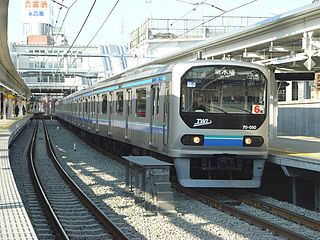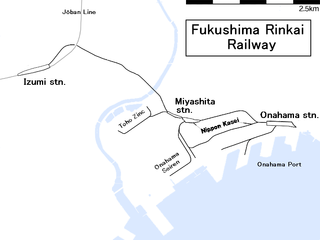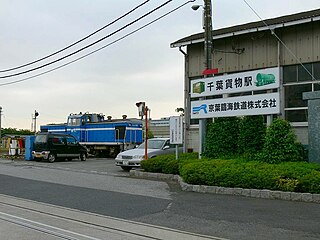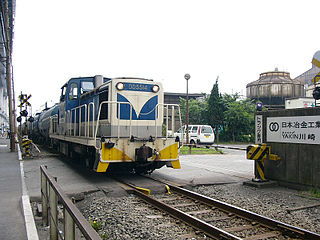
The Rinkai Line is a railway line in Tokyo, Japan. It is the only line operated by the third-sector company Tokyo Waterfront Area Rapid Transit. It connects central Tokyo to the artificial islands of Aomi and Odaiba. The line is served by some trains on the East Japan Railway Company Saikyō Line which continue on to Shinjuku, Ikebukuro, Ōmiya, and Kawagoe.

The Senseki Line is a railway line in Miyagi Prefecture, Japan, owned and operated by the East Japan Railway Company. It connects Aoba-dōri Station in Sendai to Ishinomaki Station in Ishinomaki, and provides access to the central coast areas of Miyagi Prefecture, significantly the Matsushima area. It connects with the Sendai Subway Nanboku Line at Aoba-dōri Station; the Tōhoku Shinkansen, the Tōhoku Main Line and the Senzan Line at Sendai Station; and the Ishinomaki Line in Ishinomaki. The name Senseki (仙石) comes from the combination of the first kanji of Sendai (仙台) and Ishinomaki (石巻), the two cities that the Senseki Line connects.

The Aonami Line is a third-sector railway line in the city of Nagoya operated by the Nagoya Rinkai Rapid Transit. Officially called the Nishi-Nagoyakō Line, it connects Nagoya Station with Kinjō-futō Station, and was a freight branch line of Tokaido Main Line, converted for passenger usage in October 2004.
JR Bus Tōhoku is an operator of inter-city and regional bus lines based in the Tōhoku region of Japan. A subsidiary of the East Japan Railway Company group, JR Bus Tohoku is one of eight JR Bus companies within Japan Railways Group.
The Mizushima Rinkai Railway is a third-sector railway company based in Kurashiki, Okayama, Japan. The company took over operation of three former Kurashiki City Transportation Bureau lines in 1970. It mainly transports freight for the industrial area around the Port of Mizushima, but also operates a passenger service.

The Hachinohe Rinkai Railway Line is a Japanese freight-only industrial railway line between Hachinohe Freight Terminal and Kitanuma Station, all within Hachinohe, Aomori.

The Fukushima Rinkai Railway Main Line is a Japanese freight-only railway line from Izumi, serving Onahama Freight Terminal, all in Iwaki, Fukushima. It is the only railway line operated by the Fukushima Rinkai Railway, excluding a few more industrial railway lines. The third sector company had its roots as a horsecar operator, opened in 1907 to transport salt and fish. On the development of the Port of Onahama industrial area it changed to a railway line carrying zinc and containers. It had a passenger service until 1972.

The Akita Rinkai Railway Line is a Japanese freight-only railway line between Akita Kitakō Freight Terminal and Mukaihama Freight Terminal via Akitakō Freight Terminal, all within Akita, Akita. This is the only railway line Akita Rinkai Railway operates. The third sector company was founded in 1970. The services on the line are divided by Akitakō Station. The north part is commonly called the North Line, and the south part is called the South Line. The North Line mainly transports containers of paper products from Nippon Daishōwa Paperboard Tōhoku, while the South Line transports sulfuric acid from Kosaka Smelting & Refining, via the Kosaka Line.

The Keiyō Rinkai Railway Rinkai Main Line is a Japanese freight-only railway line in Chiba Prefecture, between Soga, Chiba and Kitasode, Sodegaura. This is the only railway line Keiyō Rinkai Railway operates, but the line has two branch lines as well. The company is abbreviated as Rintetsu (臨鉄). The third sector company was founded in 1962. The line mainly transports containers or petroleum for the Keiyō Industrial Zone on Port of Chiba, Tokyo Bay.

The Kanagawa Rinkai Railway is a freight-only railway company in Kanagawa Prefecture, Japan, abbreviated as Kanarin (かなりん). The third-sector company was founded in 1963. The company also operates real-estate businesses such as warehouses. The Honmoku Line in Yokohama mainly transports containers for the Port of Yokohama, while the other three lines in Kawasaki mainly transport chemical products and petroleum for the Keihin Industrial Area.

The Nagoya Rinkai Railway is a Japanese freight-only railway company in Nagoya, Aichi, shared by Japan Freight Railway Company, Nagoya Port Authority, and Nippon Express. The third sector company was founded in 1965. The company is abbreviated as Meirin (名臨). Its lines serve the industrial area of the Nagoya Port. They mainly transport limestones via Seinō Railway, chemical products, train cars of Nagoya Railroad, or car parts of Toyota Motor.

The Kinuura Rinkai Railway is a freight-only railway company in Aichi Prefecture, Japan, operating since 1971. The two lines operated by the company lines serve the industrial area of the Port of Kinuura, Mikawa Bay. They mainly transport cement, fly ash, and calcium carbonate.

The Kinuura Rinkai Railway Handa Line is a freight-only railway line owned and operated by the Kinuura Rinkai Railway in Handa, Aichi, Japan, since 1975. The line extends 3.4 km (2.1 mi) from Higashi-Narawa Station to the terminal at Handa-Futō.

The Kinuura Rinkai Railway Hekinan Line is a freight-only railway line owned and operated by the Kinuura Rinkai Railway in Aichi Prefecture, Japan, since 1977. The line extends 8.2 km (5.1 mi) from Higashiura Station Higashiura, Aichi to the terminal at Hekinanshi in Hekinan, Aichi.

Tokyo Teleport Station is an underground railway station on the Rinkai Line in Kōtō, Tokyo, Japan, operated by Tokyo Waterfront Area Rapid Transit (TWR).

Kokusai-Tenjijō Station is a railway station on the Rinkai Line in Kōtō, Tokyo, Japan, operated by Tokyo Waterfront Area Rapid Transit (TWR). The station serves the Tokyo Big Sight exhibition centre, after which the station is named.

The Kashima Rinkai Railway Ōarai Kashima Line is a 53.0 km Japanese railway line in Ibaraki Prefecture, which connects Mito Station in Mito with Kashima Soccer Stadium Station in Kashima. It is owned and run by the third-sector railway operating company Kashima Rinkai Railway (KRT).

The Senseki-Tōhoku Line is a 47.2 km (29.3 mi) railway line in Miyagi Prefecture, Japan, opened by the East Japan Railway Company on 30 May 2015. It connects Sendai Station in Sendai with Ishinomaki Station in Ishinomaki, using existing Tōhoku Main Line tracks between Sendai and Shiogama and Senseki Line tracks between Takagimachi and Ishinomaki, linked by a new 0.3 km connection between Shiogama and Takagimachi stations.

Omachi Nishi-koen Station is a subway station on the Sendai Subway Tōzai Line in Aoba-ku, Sendai, Japan, operated by the municipal subway operator Sendai City Transportation Bureau.
This article incorporates material from the corresponding article in the Japanese Wikipedia






















